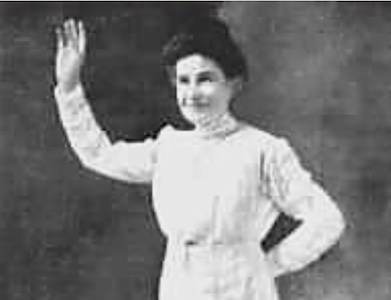Maria Woodworth-Etter, born on July 22, 1844, in Madisonville, Ohio, was never destined for an ordinary life. From her humble beginnings as the daughter of non-Christian parents to her transformation into one of the most influential evangelists and healers of her time, Maria’s story is one of faith, perseverance, and a profound dedication to spreading the message of God’s love and healing power.
Maria’s parents, Samuel Lewis and Matilda Underwood, were not religious, and therefore, she had no exposure to Christianity in her early years. However, in 1854, her parents joined the Disciple church, which marked the beginning of Maria’s religious education. Tragedy struck her family in 1857 when her father suffered from a severe case of sunstroke while working in the fields. Left with eight children to support, Maria’s mother, Matilda, and her older siblings had to take on various jobs to sustain their family.
At the age of thirteen, Maria attended a Disciples meeting where she heard the story of the cross and was deeply moved. It was during this meeting that she had a profound spiritual experience and felt a calling from God to “go to the highways and hedges and gather the lost sheep.” This calling puzzled her as the Disciples did not permit women to become ministers. Maria believed that if she married a Christian man, they could embark on missions work together. Thus, a few years later, she married Philo Horace Woodworth. However, their attempts at farming failed, and they faced significant hardships, including the heartbreaking loss of multiple children.
Tragedy struck Maria’s family repeatedly, as her first child, a son, died at a young age. Following this, another son named Fred also met an untimely death, which left Maria herself gravely ill. Her daughter, Georganna, also experienced severe illness and passed away after months of excruciating pain. Shortly before Georganna’s death, Maria gave birth to her youngest daughter, Nellie Gertrude (Gertie), who lived for only four months before passing away. Maria’s health declined as well, and she thought that her own demise was imminent. Amidst the sorrow and grief, only two of her six children remained – Willie and Lizzie.
Throughout this period of immense loss and heartache, Maria felt an unyielding calling from God to preach the Gospel to the lost souls. Finally, an opportunity arose for her to speak at a Friend’s meeting, where she experienced a vision of the pit of hell and people unaware of the danger they were in. Filled with a sense of urgency, Maria cried out for people to turn to God and be saved. Though uncertain about how to proceed, she knew she couldn’t wait any longer. Regardless of her doubts, Maria committed herself to calling sinners to repentance, starting in her local community, where she witnessed numerous conversions. The power of God would descend upon her meetings, and sinners would rush forward in repentance. These transformative encounters led her to hold nine revival meetings and establish two local churches.
Due to the failure of their farming endeavors, Maria and her husband made the decision to embark on a traveling ministry. Maria preached wherever God called, traversing the Midwest and earning a formidable reputation for the remarkable power of God at work in her meetings. However, it was during this time that Maria experienced another divine call – to pray for the sick. Initially resistant due to concerns that it would detract from her primary evangelistic mission, Maria received reassurance from Jesus that healing prayers would lead to more people being saved. Consequently, she embraced this calling and began to fervently pray for the sick.
Maria’s meetings became characterized by extraordinary displays of God’s power, including healings, visions, and trances. In 1884, she was officially licensed as an evangelist by the Churches of God Southern Assembly, founded by John Winebrenner. Drawing crowds of over 25,000 people, Maria traveled with a tent, setting it up wherever God led her.
The years between 1890 and 1900 were marked by significant challenges for Maria. The dramatic nature of her meetings and her personal experiences made her ministry highly controversial, attracting resistance from both religious and secular communities. In 1890, she was even arrested in Framingham, Massachusetts, on charges of claiming to heal people. Nevertheless, she was released when numerous individuals came forward with testimonies of their miraculous healings.
One of Maria’s most eventful meetings took place in St. Louis, Missouri, in 1890 and 1891. However, local psychiatrists brought charges of insanity against her, citing her claim of seeing visions from God. Amidst this controversy, a man named Ericson prophesied during one of her meetings that San Francisco and Oakland would be devastated by an earthquake and tidal wave on April 14th. This declaration generated significant attention and placed Maria and her group under extensive media scrutiny. When April 14th came and went without any destructive event, Ericson was institutionalized, and Maria’s group left town. Curiously, a major earthquake did strike San Francisco on April 18, 1906, leading many to believe that Ericson’s prophecy had been vindicated, albeit with a slight delay.
By the late 1880s, Maria’s marriage to Philo had deteriorated. Philo’s destructive behavior, including his alcoholism and infidelity with women who attended their meetings, posed significant challenges to Maria’s ministry. In 1891, Maria made the difficult decision to divorce him on grounds of infidelity. Philo reacted bitterly and threatened to write a critical book about her ministry unless she provided him with alimony. However, Philo remarried swiftly and unfortunately succumbed to typhoid fever within a year of their divorce. Maria, undeterred by these trials, continued her ministry with the support of her friends and associates. However, even her own denomination, the Southern Eldership of the Church of God, struggled with the unconventional nature of her meetings, leaving her under tremendous pressure to discontinue her work. Finally, in 1900, Maria gave in to the pressure and relinquished her Evangelist’s license. From that point forward, she forged her own path.
Maria’s travels brought her to Arkansas in 1902, where she encountered Samuel Etter. The two married and embarked on a journey of ministry together. Maria was aware of the Azusa Street meetings, a significant event in the early Pentecostal movement, and often expressed her admiration for the power of God demonstrated there. In 1912, she and Samuel were invited to minister at a five-month-long meeting organized by F.F. Bosworth in Dallas, Texas. This gathering received widespread coverage in Pentecostal newsletters, propelling Maria’s ministry to new heights. Pentecostals regarded her experiences and extraordinary manifestations as a sign of the Holy Spirit’s work in her life, and she became well-known to influential figures like John G. Lake, who referred to her as “Mother Etter” in his sermons. Despite the challenges she faced, Maria persevered, continuing to travel and minister extensively.
Unfortunately, Samuel’s health began to decline, and he passed away in August 1914. The strain of caring for her ailing husband, coupled with her grueling three-meeting-per-day ministry schedule, took a toll on Maria’s own health. In November of the same year, at the age of 67, she fell severely ill with pneumonia and believed her time on earth was drawing to a close. However, God granted her a powerful vision of Himself as the conqueror of death and disease, revealing that she still had work to do. By the end of January 1915, Maria had recovered enough to resume her ministry and preaching.
In 1918, God called Maria to establish a church in Indianapolis, which she utilized as a conference center. From there, she continued to travel and preach throughout the Midwest. As her health gradually deteriorated, Maria passed away on September 16, 1924, leaving behind a legacy as a revered woman of God. She was laid to rest in Indianapolis, next to her daughter and son-in-law, with her epitaph bearing the words, “Thou showest unto thousands lovingkindness.” Maria’s ministry had a profound impact on countless lives, and her teachings and experiences influenced subsequent generations of Pentecostal ministers, including her granddaughter, Beulah, and her husband, Earl Clark.
Maria Woodworth-Etter’s life exemplifies a staunch dedication to following God’s call, even in the face of adversity and controversy. Her commitment to preaching the Gospel, coupled with her unwavering faith in God’s healing power, continues to inspire believers around the world. Maria’s ministry serves as a testament to the transformative impact of divine intervention and the indomitable spirit of a faithful servant.
Discover more from Fathers Heart Ministry
Subscribe to get the latest posts sent to your email.

